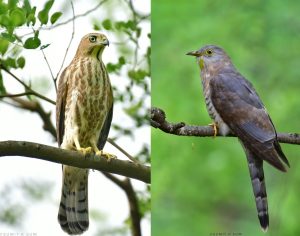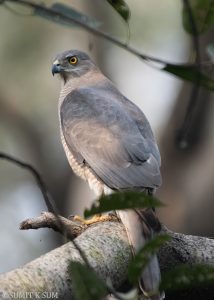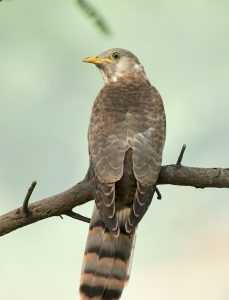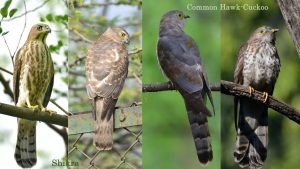Shikra vs Common Hawk-Cuckoo: How to Tell Them Apart in the Wild
The Shikra (Accipiter badius) and the Common Hawk-Cuckoo (Hierococcyx varius) are two birds that confound even seasoned birders at first glance. Their raptor-like silhouettes, piercing yellow eyes, and grey-and-white plumage make them easy to mistake for each other. But scratch the surface, and a fascinating story of mimicry and adaptation unfolds.

Here’s a field-based guide to help you confidently identify whether that sharp-eyed bird in your backyard is a true raptor or a cuckoo in hawk’s clothing.
Taxonomy and Nature Comparison – Shikra vs Common Hawk-Cuckoo
|
Trait |
Shikra | |
| Image |  |
 |
| Family | Accipitridae (raptors) | Cuculidae (cuckoos) |
| Diet | Carnivore (hunts prey) | Insectivore (feeds on caterpillars, insects) |
| Behavior | True predator | Mimic and brood parasite |
| Nature | Territorial, aggressive | Shy, secretive |
Plumage and Markings
Upperparts:
Shikra: Uniform blue-grey or slate-grey upperparts with a subtle sheen.
Common Hawk-Cuckoo: Slightly duller grey; lacks the sharp contrast of a raptor.
Underparts:
Shikra: Finely barred rufous or chestnut underparts with tight horizontal stripes.
Hawk-Cuckoo: Coarser, looser dark grey barring on white or buff background.
Tail:
Shikra: Shorter tail with 3–4 narrow, evenly spaced dark bands.
Hawk-Cuckoo: Longer tail with broader, more contrasting black and grey bands and a white tip.
Legs:
Shikra: Yellow legs, strong talons (used to catch prey).
Hawk-Cuckoo: Slender yellow legs, weak claws (not built for catching prey).

Head and Facial Features
Eyes:
Both species have striking yellow irises, but in the field:
Shikra: Smaller head with flatter crown; intense, forward-staring gaze.
Hawk-Cuckoo: More rounded head, slightly raised crown, softer expression.
Beak:
Shikra: Strong, hooked beak typical of birds of prey.
Hawk-Cuckoo: Slender, slightly curved beak, more delicate.
Flight Pattern Comparison
Shikra: Classic raptor flight—short glides with rapid wingbeats, very direct and agile.
Hawk-Cuckoo: More erratic, weak flapping, gliding like a cuckoo; lacks the confident control of a Shikra.
Perching Behavior
Shikra: Perches openly, often high on bare branches, scanning surroundings with an upright stance.
Hawk-Cuckoo: Perches more secretly inside foliage or mid-canopy, often wagging its long tail.
Vocalization
Shikra: Sharp, repeated “kik-kik-kik” call, especially during breeding season or alarm.
Common Hawk-Cuckoo: The iconic “brain-fever, brain-fever!” rising call, often repeated for hours during the hot months.
Pro Tip: If the bird is calling loudly from within the trees, especially in summer—it’s almost always the cuckoo.
Seasonal Clues
Shikra: Resident throughout India all year round; often seen with young in nesting season.
Common Hawk-Cuckoo: Most vocal and visible from March to July (breeding season); more silent or absent during winter in north India.
Quick Comparison Table to Identify Shikra and Common Hawk-Cuckoo
|
Feature |
Shikra |
Common Hawk-Cuckoo |
| Eye Color | Yellow | Yellow |
| Underpart Barring | Fine and uniform | Coarse and spaced |
| Tail | Short, narrow bands | Long, broad bands, white tip |
| Beak | Strong, hooked | Slim, curved |
| Call | “Kik-kik-kik” | “Brain-fever!” |
| Hunting | Hunts birds, lizards | Gleans insects, caterpillars |
| Nesting | Builds nest | Lays in Jungle Babbler’s nest |
| Perch Posture | Upright, open | Tail wagging, semi-hidden |
Why the Confusion Exists: Mimicry in Nature
The similarity between the two is not accidental. The Common Hawk-Cuckoo is a mimic, and this mimicry may serve to reduce mobbing by small birds. By resembling a predator, it avoids being attacked while sneaking around host nests to lay its eggs—a classic example of Batesian mimicry in birds.
Conclusion
The Shikra and the Common Hawk-Cuckoo share a visual resemblance but lead remarkably different lives, one a hunter, the other a mimic and parasite. By paying attention to tail length, call, flight style, and posture, you can reliably tell these two birds apart in the field.
So, the next time a raptor-like bird lands on a branch in your neighborhood or calls out in the blazing heat, take a closer look. It might just be the cuckoo that pretends to be a hawk.

